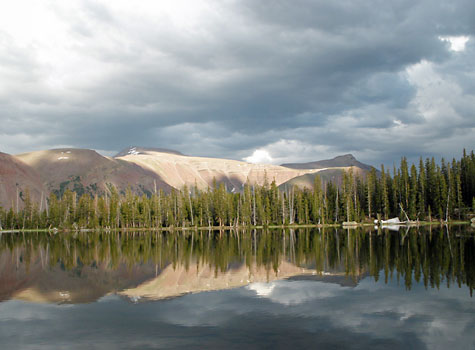Study shows how much enters air from plants, soil, surface water

More than a quarter of the rain and snow that falls on continents reaches the oceans as runoff. Where does the rest go?
Now results of a new study help answer that question: two-thirds of the remaining water comes from plants, more than a quarter lands on leaves and evaporates, and what’s left evaporates from soil and from lakes, rivers and streams.
„The question is, when rain falls on the landscape, where does it go?“ asks University of Utah geochemist Gabe Bowen, senior author of a paper on the findings published today in the journal Science.
„Water on the continents sustains all plant life, all agriculture, humans, aquatic ecosystems. But the breakdown–how much is used for those things–has always been unclear.
„Some previous estimates suggested that more water was used by plants than we find [in our study]. It means that plants are less productive globally than we thought, or that plants are more efficient at using water than we assumed.“
University of Utah hydrologist Stephen Good, the study’s first author, adds, „We’ve broken down the possible pathways water takes as it moves from rainfall and snowfall through soils, plants and rivers. Here we’ve found the proportion of water that returns to the atmosphere though plants, soils and open water.“
Pathways of Earth’s water
The study used hydrogen isotope ratios of water in rain, rivers and the atmosphere from samples and satellite measurements to conclude that of all precipitation over land–excluding river runoff to the oceans–these amounts are released by other means:
- 64 percent (55,000 cubic kilometers or 13,200 cubic miles) is released or essentially exhaled by plants, a process called transpiration. This is lower than estimates by other research, which concluded that plant transpiration accounted for more than 80 percent of water that falls on land and does not flow to the seas.
- 6 percent (5,000 cubic kilometers or 1,200 cubic miles) evaporates from soils.
- 3 percent (2,000 cubic kilometers or 480 cubic miles) evaporates from lakes, streams and rivers.
- Previous research indicated that the other 27 percent (23,000 cubic kilometers or 5,520 cubic miles) falls on leaves and evaporates, a process called interception.
„It’s important to understand the amount of water that goes through each of these pathways,“ Good says. „The most important pathway is the water that passes through plants because it is directly related to the productivity of natural and agricultural plants.“
In another key finding, the researchers showed how much rainwater or snowmelt passing through soils is available for plants to use before it enters groundwater, lakes or streams.
They found that this „connectivity“ is 38 percent: Only 38 percent of water entering groundwater, lakes or rivers interacts with soil, and the rest „moves rapidly into groundwater and lakes and rivers without spending much time in soil,“ Bowen says.
„Lot of things happen in soils: nutrients, fertilizers, contaminants, various biological processes. If water that goes to streams and groundwater moves rapidly through soil, it has less interaction with those processes.
„It means the soils and rest of the hydrologic cycle are somewhat separated. If we want to predict future climate change, hydrologic change, and water quality, we need to account for the fact that most water doesn’t interact with soils before it reaches streams and groundwater.“
Significance: for agriculture, water supplies, climate
The researchers conducted the study with David Noone of Oregon State University. Funding came from the National Science Foundation’s (NSF) Divisions of Atmospheric and Geospace Sciences, and Environmental Biology, through NSF’s MacroSystems Biology Program.
„These scientists found a way to answer basic questions about what happens to rainwater when it falls on land,“ says Eric DeWeaver, program director in NSF’s Division of Atmospheric and Geospace Sciences. „The answers have important implications for water quality, plant productivity and peak streamflow. They give us a window on the inner workings of ecosystems and watersheds that’s scientifically fascinating and useful.“
Adds Henry Gholz, program director in NSF’s Division of Environmental Biology, „Getting what’s called Earth’s ‘water balance‘ right is the key to understanding how our climate and ecosystems interact.
„This new analysis offers an estimate of hard-to-come-by global water measurements: water used by plants and water that evaporates from land. By knowing these amounts, we can better understand how ecosystems, including watersheds, work. In a decade when our reserves of freshwater are declining–in some cases to critically low levels–this information couldn’t be more timely.“
Good says that knowing how much water plants release or transpire is important „so we can have an understanding of how productive ecosystems and agriculture are. How much water plants use determines how much food we get and how many leaves are on the trees.“
Earth’s water cycle is changing as climate warms, „so with shifts in future water availability, we also will see shifts in ecosystems and agriculture,“ Good says. „Understanding the connection between the water cycle and plant growth is important.“
When leaves release water, they consume carbon dioxide, the major climate-warming gas. Soil doesn’t do that. Knowing how much water plants transpire, Bowen says, „helps us understand how plants contribute to reducing global warming.“
The U.S. Department of Defense also funded the research.
www.nsf.gov
National Science Foundation







